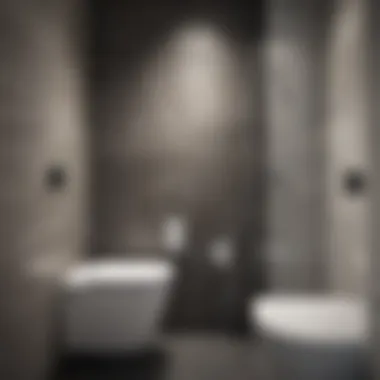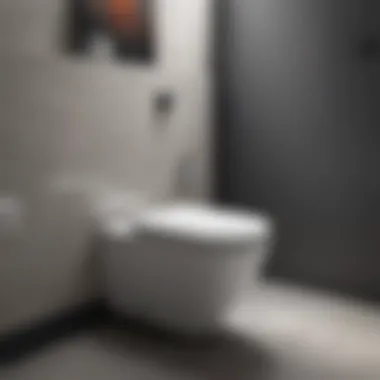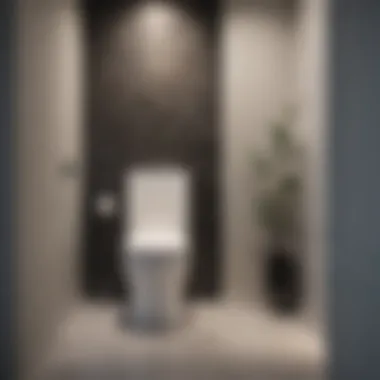Low Profile Toilets for Small Bathrooms: Practical Solutions


Intro
Navigating the intricacies of small bathroom design often presents unique challenges. One pivotal element in optimizing space is the toilet. Low profile toilets emerge as practical solutions, effectively merging functionality with design in compact environments. As a homeowner or housewife, understanding the benefits and features of these toilets can greatly enhance your living space. This guide aims to illuminate various aspects of low profile toilets, from trending styles to essential maintenance tips, equipping you with the knowledge to make informed decisions.
Trending Styles
Modern Minimalism
In today's design landscape, modern minimalism stands out. The appeal lies in clean lines and uncluttered aesthetics. Low profile toilets fit seamlessly into this theme, offering sleek designs that do not dominate the bathroom. These toilets typically feature smooth surfaces and discreet plumbing, making them a favorite for those aiming for a sophisticated look. Their compact designs help maintain an open flow in smaller areas, promoting a sense of spaciousness.
Cozy Rustic
For those who appreciate warmth and charm, cozy rustic styles can also be embraced in small bathrooms. Low profile toilets in this category often feature natural materials and earthy tones. The incorporation of such designs can create a balanced environment, blending modern convenience with traditional aesthetics. Consider options with wood accents or muted colors that provide a comforting atmosphere without sacrificing space.
Color Palettes
Calming Neutrals
Color plays a crucial role in small spaces. Calming neutrals are a popular choice for low profile toilets, as they promote a serene environment. Shades like beige, soft gray, and creamy white can easily integrate into various bathroom designs. Such colors not only help in visually expanding the space but also create a tranquil atmosphere, promoting relaxation during your personal time.
Bold Accents
On the other hand, using bold accents can also elevate small bathroom designs. A low profile toilet with a touch of color can serve as a statement piece in an otherwise neutral space. Consider navy blue or forest green options for a striking contrast. These colors can add character without overwhelming the area, ensuring that your bathroom is both functional and stylish.
"Choosing the right low profile toilet can significantly enhance your bathroom experience, making it both elegant and practical."
Understanding Low Profile Toilets
Low profile toilets are essential fixtures for small bathrooms. Their compact design helps in utilizing limited space efficiently. This section helps to understand how these toilets function and why they are a practical choice for homeowners facing spatial constraints.
Definition and Functionality
A low profile toilet typically features a shorter height compared to standard models. These toilets usually stand at around 15 inches in height or less, making them more suitable for cramped areas. The functionality of low profile toilets remains consistent with traditional designs, offering the same flushing mechanism and efficiency, but packaged in a more space-friendly frame. This feature enables them to fit comfortably in small bathrooms where every inch counts.
Benefits of Choosing Low Profile Toilets
Low profile toilets offer several benefits. First, the space-saving design allows for better movement within tiny bathrooms. Homeowners can arrange other bathroom essentials without feeling cramped. Second, they come in various styles, blending well with existing decor while still providing modern convenience. This makes them fashionable yet functional. Additionally, many models focus on water efficiency, providing eco-friendly options for those mindful of water consumption.
Here are some advantages:
- Space Efficiency: Designed to fit snugly, making them perfect for smaller layouts.
- Accessibility: Lower height can be easier for children or individuals with mobility challenges to use.
- Cost-Effective: Given their design, they can often be less expensive to install and maintain than their taller counterparts.
"Understanding low profile toilets gives homeowners the knowledge they need to optimize their limited bathroom spaces effectively."
The exploration of low profile toilets reveals how they can enhance bathroom functionality while considering space limitations. As we delve deeper, factors such as specific design options and maintenance will further guide homeowners in making informed decisions.
Factors to Consider When Selecting a Low Profile Toilet
Choosing a low profile toilet for a small bathroom is not merely about aesthetics but also functionality and efficiency. Given the limited space in many modern homes, understanding what factors to consider is essential. Each aspect, from the physical dimensions of the toilet to its water consumption, plays a critical role in maximizing the utility of available space. Here are the key factors to guide your decision-making process.
Space Limitations
When selecting a low profile toilet, the first step is measuring the available space in your bathroom. Many small bathrooms offer restricted movement, making it crucial to choose a toilet that fits comfortably without overcrowding the area. Ideally, there should be a minimum of 15 inches from the center of the toilet to any adjacent obstruction.
Consider the overall dimensions: length, width, and height. Some models prioritize compact designs without compromising comfort. Additionally, it is advisable to evaluate the shape of the toilet. Elongated toilets, though slightly larger, provide more comfort, while round toilets fit smaller spaces more effectively.
Height Requirements
Height is another significant factor when selecting a low profile toilet. Standard toilets usually measure between 14 to 15 inches, while low profile options can be as low as 10 inches. This aspect is particularly important when considering the comfort of young children or individuals with mobility challenges.
A lower seat height may be beneficial for small children, making it easier for them to use the toilet. Conversely, for adults or elderly persons, a toilet that approaches the standard height can enhance comfort and accessibility. Hence, take into account the users who will be interacting with the toilet prior to making a selection.
Water Efficiency
Water efficiency is a critical consideration when selecting a toilet, both for environmental reasons and potential savings on water bills. Low profile toilets often utilize modern technology to minimize water usage. Look for models that are designed to comply with strict water-saving standards. Many low profile toilets use dual-flush systems, allowing the user to select between different flush volumes depending on the waste type.
This functionality can significantly reduce the overall water consumption in your household. An efficient low profile toilet typically uses no more than 1.28 gallons per flush. Additionally, the WaterSense label can guide you in finding toilets that meet specific efficiency criteria.
Key Takeaway: Space, height, and water efficiency are fundamental factors when selecting a low profile toilet. Assess these elements thoroughly to ensure the right choice for your small bathroom needs.
Design and Style Options


When considering low profile toilets for small bathrooms, design and style options become essential factors. These toilets should not only fit into the space but also enhance the overall aesthetic and functionality of the bathroom. Aesthetic harmony is important because it can influence the mood and usability of the entire area. Homeowners often seek toilets that align with their existing decor and create a cohesive look.
In this section, we will explore contemporary designs, classic styles, and the various color and finish choices available. This knowledge will help you make a well-informed decision while selecting a low profile toilet that meets your practical and aesthetic needs.
Contemporary Designs
Contemporary designs in low profile toilets emphasize sleek lines and minimalist shapes. They often feature a streamlined appearance, which can make a small bathroom feel larger. These toilets typically have hidden trapways, a smooth surface that's easy to clean, and modern flushing mechanisms.
Some key characteristics of contemporary low profile toilets include:
- Compact dimensions that fit snugly in tight spaces.
- Integrated technologies like dual-flush options, allowing for better water efficiency.
- Stylish finishes, such as chrome or matte black, which lend a modern touch.
Additionally, avant-garde styles focus on functionality without sacrificing a modern aesthetic, appealing to those who appreciate both form and function.
Classic and Traditional Styles
In contrast to contemporary designs, classic and traditional styles retain an air of timeless elegance. These low profile toilets often feature rounded edges and decorative elements that can evoke a sense of nostalgia. Although they are slightly bulkier, they offer a charming appeal, suitable for a more traditional bathroom setting.
Notable features include:
- Ornate details that may include intricate carvings or beveled edges.
- Colors that complement classic design schemes, such as off-white or soft pastel hues.
- Comfort height options for added convenience.
Choosing a classic style can help maintain harmony in an older home or in spaces that embrace vintage designs, bridging functionality and style.
Color and Finish Choices
When it comes to color and finish choices, the options for low profile toilets have expanded significantly. Homeowners are no longer limited to standard white; now they can pick from a wide palette. Choosing the right color can complement the overall decor of the bathroom and create a visually appealing focal point.
Here are some common color and finish options:
- Traditional White: Always a popular choice, offering a clean, fresh look.
- Soft Pastel Shades: Colors like light blue and pale green can add subtle accents without overwhelming the space.
- Bold Colors: For those who want to make a statement, darker hues, such as navy or black, can provide contrast in brighter spaces.
- Satin or Glossy Finishes: These finishes impact the light reflectivity and can enhance or diminish the overall appeal.
In summary, when selecting low profile toilets, the design and style options available can significantly influence your bathroom’s appearance and efficiency. Choosing the right design ensures that your toilet does not just function well, but also enhances the character of your small bathroom.
"Design is not just what it looks like and feels like. Design is how it works." - Steve Jobs
By understanding contemporary styles, classic designs, and various color and finish choices, you can make a decision that suits both your practical needs and aesthetic desires.
Installation Considerations
When deciding to incorporate a low profile toilet in your small bathroom, installation considerations come into play significantly. Proper installation ensures not only functionality but also longevity of the unit. Choosing the right approach, whether professional or DIY, can affect the overall outcome and satisfaction with the toilet.
Professional Installation vs. DIY
Opting for professional installation can provide several advantages. Plumbers have the experience to handle any unexpected issues that may arise during installation, such as plumbing complications or misalignments. This can save time and reduce potential errors, which might be costly in the long run. Moreover, warranties are often contingent on professional installation, giving you peace of mind concerning any repairs down the line.
On the other hand, DIY installation can be beneficial for those who possess basic plumbing skills. It allows homeowners to save on labor costs and engage in a more hands-on home improvement project. Many low profile toilets come with detailed installation instructions, making it feasible for someone with determination and patience. However, it is crucial to understand your own limitations and be aware of the risks involved. If uncertain, seeking professional help can avoid costly mistakes.
Necessary Tools and Materials
To successfully install a low profile toilet, gathering the right tools and materials is essential. Here is a list summarizing these items:
- Tools:
- Materials:
- Adjustable wrench
- Screwdriver set
- Level
- Plumber's tape
- Caulking gun
- New toilet (low profile model)
- Wax ring or rubber gasket
- Toilet bolts
- Water supply line (if necessary)
It's wise to prepare these items ahead of time. This approach ensures a smoother installation process, as interruptions for missing materials can lead to unnecessary frustration.
Consider this as our guiding principle:
"Proper planning and execution are crucial for successful installation and functioning of your low profile toilet."
In summary, understanding installation considerations is fundamental when selecting a low profile toilet. Whether you choose professional help or a DIY approach, being well-prepared will ultimately lead to a functional and stylish fit in your small bathroom.
Maintenance Tips for Low Profile Toilets
Proper maintenance of low profile toilets is essential to ensure their longevity and functionality, particularly in small bathrooms where space is at a premium. Maintaining these toilets not only prolongs their life but also enhances their efficiency and hygiene. Regular upkeep can prevent common problems, saving both time and money in the long run.
Regular Cleaning Practices
Low profile toilets require consistent cleaning to prevent stains and build-up. Adopting a routine cleaning practice is vital. Here are some recommended approaches:


- Weekly Cleaning: Use a toilet bowl cleaner that is not overly harsh. Apply it inside the bowl and scrub with a toilet brush. Ensure you also clean under the rim where stains often accumulate.
- Exterior Wiping: The outer surfaces should be wiped down with a damp cloth and mild disinfectant cleaner. Pay attention to the flush handle, as this area tends to harbor germs.
- Preventing Hard Water Stains: If you have hard water, consider using a water softener. This reduces mineral deposits that can lead to stains inside the bowl. Regular scrubbing will help keep your toilet looking fresh.
Identifying Common Issues
Low profile toilets, like any plumbing fixture, can develop issues. Recognizing these early helps in timely intervention. Common problems include:
- Leaking Tanks: If you notice water pooling around the base of the toilet, it could indicate a leak. Check the seals and gaskets for wear.
- Clogging: Frequent clogs may suggest a problem with the drain line. Ensure you avoid flushing non-degradable items.
- Weak Flushing Power: If the water does not clear the bowl effectively, it might be due to a blocked jet. Periodically inspect and clean these jets to maintain proper flow.
Repair and Replacement Options
Knowing when to repair or replace components is crucial. It can often be more cost-effective to replace than to continually fix issues. Key repair and replacement options include:
- Flapper Valve Replacement: If the toilet runs continuously, the flapper valve might require changing. This is an easy DIY replacement that can resolve the issue cheaply.
- Wax Ring Replacement: If leaks occur between the toilet and floor, a new wax ring can help. This requires removing the toilet but is straightforward for those comfortable with DIY tasks.
- Entire Unit Consideration: If your low profile toilet is frequently problematic and outdated, consider replacing it with a new energy-efficient model. This can lead to significant savings on water bills and maintenance efforts.
Regular maintenance not only enhances the performance of low profile toilets but also contributes to a cleaner and healthier bathroom environment. By identifying issues and implementing a cleaning schedule, homeowners can ensure their investment serves them well for years.
Sustainability Aspects of Low Profile Toilets
The increasing emphasis on sustainability in home design extends to the choice of toilets, particularly in small bathrooms. Low profile toilets are not just space-savers; they also offer a more sustainable approach to bathroom fixtures. This section explores different sustainability aspects related to these toilets, highlighting their benefits and features that cater to eco-conscious homeowners.
Water-Saving Technologies
Low profile toilets are increasingly equipped with water-saving technologies. These toilets typically utilize dual-flush systems, which allow users to choose between a lower flush for liquid waste and a higher one for solid waste. This feature can significantly reduce water usage per flush. For example, flushing with just 1.28 gallons instead of the standard 1.6 gallons saves water without sacrificing performance. According to the Environmental Protection Agency (EPA), efficient toilets can save an average of 20,000 gallons of water per year for a family of four.
In addition, many low profile models incorporate advanced design methods that enhance flushing efficiency. Some utilize pressure-assisted systems, which rely on air pressure to flush waste effectively, leading to less water usage overall. These innovations represent a step forward in both technology and environmental responsibility, making low profile toilets a sound choice for eco-conscious homeowners.
Eco-Friendly Materials
The materials used in the production of low profile toilets have a significant impact on their sustainability. Many manufacturers are now prioritizing eco-friendly materials in their designs. These can include recycled porcelain and low-VOC (volatile organic compounds) finishes. Choosing toilets made from these materials can help reduce the carbon footprint associated with manufacturing.
Using recycled materials not only conserves resources but also decreases landfill waste. Furthermore, finishes that emit fewer harmful chemicals promote a healthier indoor environment. Homeowners should look for certifications that indicate the use of sustainable practices and materials. By selecting low profile toilets made from high-quality eco-friendly materials, homeowners can contribute to a more sustainable future while enhancing the functionality of their small bathrooms.
Comparisons with Traditional Toilets
In the context of small bathrooms, understanding the differences between low profile toilets and traditional toilets is critical. This comparison provides insights into key factors such as space utilization, cost, and overall functionality. Low profile toilets are designed specifically to address the space limitations typical of compact settings. This makes them an attractive option for homeowners looking to maximize efficiency in their bathrooms while also maintaining comfort and style.
Space Efficiency
Low profile toilets are often shorter and more compact than traditional models. This unique design allows for a better fit in confined areas. By taking up less vertical space, these toilets can significantly enhance the flow and usability of a small bathroom. Homeowners can experience a less cramped environment, making daily routines smoother and more pleasant.
A few reasons why low profile toilets excel in space efficiency are:
- Reduced Height: Many low profile models stand lower than the standard height of 15 to 17 inches, which can make them easier to incorporate under shelving or cabinetry.
- Compact Footprint: Their smaller base size means they can fit into tighter corners or smaller bathroom layouts where traditional toilets may not fit.
- Versatile Placement: The elegant design allows for various positioning, which can open up space for other essentials like storage solutions.
"Homeowners can enjoy a more open bathroom atmosphere by choosing a low profile design, fostering both aesthetic appeal and practicality."
Cost Considerations
When it comes to cost, low profile toilets can present both advantages and potential drawbacks compared to traditional toilets. The initial purchase price can vary. Some low profile models may be less expensive than their traditional counterparts, while others, particularly those with advanced features, may exceed expectations.
Factors to consider include:
- Installation Expenses: The installation of low profile toilets may be simpler in smaller bathrooms, potentially lowering labor costs if hiring professionals.
- Long-Term Savings: Many low profile toilets incorporate water-saving technologies, which can lead to reduced utility bills over time.
- Model Variety: With a range of prices available, homeowners can find models that fit their budgets while still benefiting from space-saving designs.
In summary, evaluating both the space efficiency and cost considerations associated with low profile toilets in comparison to traditional toilets can greatly impact the decision-making process for homeowners. These factors contribute to more informed choices, ensuring that practicality aligns with long-term satisfaction.
The Role of Technology in Modern Toilets
Technology has transformed many aspects of our daily lives, including bathroom fixtures. Modern toilets now come with innovative features that enhance comfort, efficiency, and user-friendliness. In the context of low profile toilets, technology brings additional benefits to compact spaces. These advancements make maintenance easier and contribute positively to the sustainability of bathrooms.
Smart Toilets Overview
Smart toilets are an example of how technology integrates into everyday bathroom essentials. These toilets often include advanced features like automatic flushing, integrated bidets, and heated seats. Some smart toilets, such as the Toto Neorest series, even offer self-cleaning mechanisms that minimize manual cleaning efforts.
Benefits of smart toilets include:
- Improved hygiene with touchless technology
- Customizable settings for each user
- Water efficiency compared to traditional toilets
- Enhanced user experience, boosting comfort during use
The convenience of a smart toilet can be appealing for those managing small bathrooms. It reduces the footprint while delivering high functionality.
Remote Features and Adjustability


Technology allows for remote features and adjustability, making toilets more accessible and comfortable. Many smart toilets enable users to control settings via smartphone applications. For instance, the Kohler Veil can be adjusted for water temperature and pressure from an app. This remote access increases ease of use, especially for individuals with mobility impairments.
Common adjustable features include:
- Seat height adjustments for better accessibility
- Remote flushing for a touchless experience
- Customizable lighting under the toilet for visibility at night
These features are particularly useful in small bathrooms, where space can often impact accessibility and functionality. By incorporating technology, low profile toilets not only meet the physical needs of users but also provide a heightened sense of luxury and convenience in their design.
Regulatory and Compliance Considerations
When it comes to selecting a low profile toilet for your small bathroom, understanding regulatory and compliance considerations is crucial. These guidelines ensure that not only does your toilet run efficiently, but it also adheres to safety and environmental standards. Complying with such regulations can prevent costly fines and ensure that you are making a sound investment in your home. Moreover, awareness of these requirements can guide your installation process and restroom design.
Building Codes
Building codes specific to plumbing and fixtures highly influence the installation of toilets. These codes vary by location, and usually, they dictate minimum requirements for water flow rates, drain sizes, venting requirements, and zoning restrictions. Familiarizing yourself with local building codes can help avoid issues during installation or future renovations.
- Water Flow Rates: Low profile toilets are often designed to use less water. You must confirm what the minimum flushing requirements are as prescribed by your jurisdiction.
- Drain Sizes: Certain codes may specify drain line diameters. Ensure that your toilet's discharge size matches local regulations to prevent plumbing issues.
- Ventilation Needs: Proper ventilation is often a code requirement. It ensures that the sewer gas does not enter your bathroom, which can create health hazards.
In short, adhere to local building codes to facilitate a smooth installation and operation, as well as to maintain the integrity of your structure.
Water Use Regulations
Water use regulations offer significant guidance when selecting and installing a low profile toilet. These regulations aim to minimize water wastage by specifying maximum allowable water usage per flush. For homeowners looking to install a low profile toilet, it is essential to select models that comply with these rules.
- Efficiency Standards: In many areas, low profile toilets must meet efficiency standards set by agencies like the Environmental Protection Agency (EPA). These standards specify a maximum flush volume, often 1.28 gallons per flush for standard toilets.
- Incentives for Compliance: Some regions offer incentives for homeowners who install water-efficient toilets. These programs not only encourage eco-friendly choices but may also provide rebates that offset installation costs.
- Long-Term Benefits: Choosing compliant low profile toilets not only adds value to your home but also supports sustainable practices in your community. Less water use can lead to lower utility bills over time.
Understanding and adhering to water use regulations can assist you in making both environmentally and economically sound decisions.
Therefore, it is important to familiarize yourself with local water regulations before making an installation decision. Keep these rules in mind as you explore various low profile options to ensure that you are compliant and able to enjoy the benefits right away.
Consumer Reviews and User Experiences
Understanding consumer reviews and user experiences is crucial in the context of low profile toilets for small bathrooms. These reviews serve as a reflection of real-world performance, offering insights that go beyond technical specifications. Thus, analyzing feedback can assist potential buyers in making informed decisions while choosing a suitable model for their space.
User experiences often highlight tangible benefits and concerns related to these toilets. Often, satisfied owners share how these toilets save space without compromising comfort or style.
Common Praise and Criticism
Many consumers appreciate the design of low profile toilets, noting how they fit seamlessly into tight spaces. Users frequently mention the following points of praise:
- Space Efficiency: Customers often point out that low profile toilets can create a more open feel in smaller bathrooms.
- Water Usage: Users appreciate models that incorporate water-saving features, contributing to eco-efficiency and lower bills.
- Ease of Cleaning: Many reviews emphasize that the design allows for easier access and maintenance.
However, not all reviews are positive. Common criticisms often include:
- Comfort Issues: Some users find the lower height uncomfortable, particularly for older adults.
- Flushing Power: A number of reviews mention performance concerns regarding flushing capabilities.
- Limited Styles: Some consumers feel that options in design can be lacking, leaving less room for personal choice.
"Readability of performance reviews is essential to grasp how low profile toilets function in real settings; what excels in the showroom might not perform the same in practice."
Brand Comparisons
When exploring different brands of low profile toilets, it is essential to look at what each brand offers in terms of reliability and customer satisfaction. Here are a few brands frequently mentioned:
- Toto: Known for innovative designs and outstanding water efficiency, Toto toilets often receive high praise for performance and aesthetics.
- Kohler: This brand is well-regarded for integrating modern technology and classic styles, catering to a variety of consumer preferences.
- American Standard: With a strong reputation for durability, American Standard models typically perform well in both functionality and design.
Comparing these brands involves assessing consumer feedback on various factors:
- Price Range: Not all models are created equal, and price can vary widely based on features.
- Warranty and Service: Evaluating the warranty provided by each brand can offer peace of mind for potential buyers.
- User Friendly: Ease of installation and accessibility of customer service are crucial considerations.
To make a well-informed choice, house owners and housewives should dedicate time to research both reviews and specifications. Reading multiple sources can yield a more balanced perspective on what suits their unique needs.
Epilogue on Low Profile Toilets
In the context of modern home design, low profile toilets play a crucial role, especially for homeowners with limited bathroom space. Their streamlined design not only saves physical space but also offers various advantages that contribute to overall bathroom efficiency. The intricate balance of functionality and aesthetic appeal is essential in smaller rooms. As such, selecting the right low profile toilet can transform a cramped area into a more usable and visually pleasing environment.
Summarizing Key Points
Low profile toilets are specifically designed to accommodate small bathrooms, presenting multiple benefits:
- Space Efficiency: These toilets require less vertical clearance, making them ideal for bathrooms with low ceilings or tight spaces.
- Aesthetic Versatility: Available in diverse styles, they can complement various design themes, from contemporary to classic.
- Water Conservation: Many models integrate water-saving technologies to promote environmental sustainability, thereby lowering utility bills.
- Ease of Maintenance: Maintenance concerns are minimal with low profile options, as they are generally easy to clean due to their simpler construction.
Carefully considering these elements can guide housewives and homeowners in making informed choices that enhance their living spaces.
Final Recommendations
For those looking to invest in a low profile toilet, here are some useful recommendations:
- Assess Your Space: Measure the bathroom dimensions. Ensure that the chosen model fits comfortably without compromising mobility.
- Research Water Efficiency: Prioritize toilets that meet or exceed the EPA's WaterSense criteria. This not only helps the environment but also reduces water bills.
- Choose the Right Height: Consider the height that best suits the residents of your home. Models exist for both standard and comfort heights.
- Consult Professional Opinions: If uncertain about installation, consulting with a plumber or contractor can provide insights and prevent future issues.
- Read User Reviews: Check consumer feedback on specific brands or models. Experiences shared can offer practical advice that influences your decision.
By implementing these recommendations, homeowners can effectively utilize low profile toilets to elevate their bathrooms' efficiency and style.















